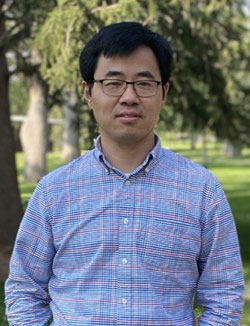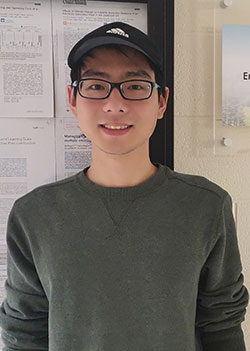UW Researchers Probe Potential Water Impact of Bioenergy With Carbon Capture and Sequestration
Published September 28, 2021

New research by University of Wyoming scientists examines water consumption when combining bioenergy production with carbon capture and sequestration, and calls for a close coordination of technology, resources and policy in the transition to a net-zero carbon energy future.
Haibo Zhai, the Roy and Caryl Cline Chair of Engineering, Environment and Natural Resources and an associate professor, and Zitao Wu, a Ph.D. student in the Department of Civil and Architectural Engineering and Construction Management, detail their research in a paper titled “Consumptive life cycle water use of biomass-to-power plants with carbon capture and sequestration.” It’s scheduled for publication in December in Applied Energy, a highly regarded journal that provides a forum for information on energy innovation, research, development and demonstration.
Bioenergy with carbon capture and sequestration is a carbon removal technique in which organic material is converted into heat, electricity, or liquid or gas fuels, with the carbon emissions from this bioenergy conversion captured and stored in geological formations or embedded in long-lasting products.
The technique has been regarded by the Intergovernmental Panel on Climate Change as one of the major negative emissions technologies that may be needed to limit global warming over this century. A strategic research agenda outlined by the U.S. National Academies of Sciences, Engineering and Medicine also has addressed the potential role of the technique in transitioning to a net-zero carbon future. However, large-scale deployment likely will face challenges, such as concerns over water and land sustainability.
The research by Zhai and Wu reveals potential significant water impacts from bioenergy production with carbon capture and sequestration.
“We have developed a life-cycle water assessment framework in a bottom-up manner to address critical gaps in current knowledge: the lack of systematic characterization of water consumption for (the technique) and the lack of a quantitative understanding of the variability and uncertainty in life-cycle water consumption,” Wu says. “This framework can be applied to systematically characterize the consumptive water use of biomass-to-power plants with carbon capture and sequestration across a fuel-based life cycle, and to demonstrate its dependence on the type, production location and power conversion approach of biomass feedstock.”

Biomass can be converted to power by burning it along with coal or burning only biomass.
“While co-firing biomass and coal at power plants with carbon capture and sequestration can achieve net-zero carbon emissions on a life-cycle basis, it can increase the overall freshwater use, mainly because a large amount of water is consumed for biomass production,” Zhai says. “Dedicated biomass combustion with carbon capture can achieve negative emissions but significantly increase the life-cycle freshwater consumption by a factor of 55 or more, compared to complete coal combustion with carbon capture and sequestration.”
Because large-scale deployment of the technique may pose a challenge for water sustainability, depending on the location, the researchers see pronounced trade-offs in carbon mitigation and water use. Given the potential significant impact on water resources, use of the technique should be planned in the context of sustainability.
“While planning large-scale deployment of bioenergy with carbon capture and sequestration, a rigorous multicriteria decision analysis is strongly needed, which should take into account trade-offs in climate and nonclimate metrics under regional constraints,” Zhai says.
Location does matter for large-scale deployment of the technique, and bioenergy planning should capture the potential local constraints of natural resources, the researchers say. They plan to develop a regional assessment framework that integrates energy planning, carbon mitigation and water resource management under local resource constraints to support development, harmonization and integration of technological strategies and energy policies for deep decarbonization in the context of sustainability.
Before coming to UW in fall 2020, Zhai was an associate research professor of engineering and public policy at Carnegie Mellon University, where he is now an adjunct associate professor. At UW, he has developed a computational laboratory for low-carbon energy and environmental sustainability, which promotes a long-term vision for the role of both technology and policy to cope with complex energy, environmental and natural resource challenges.

